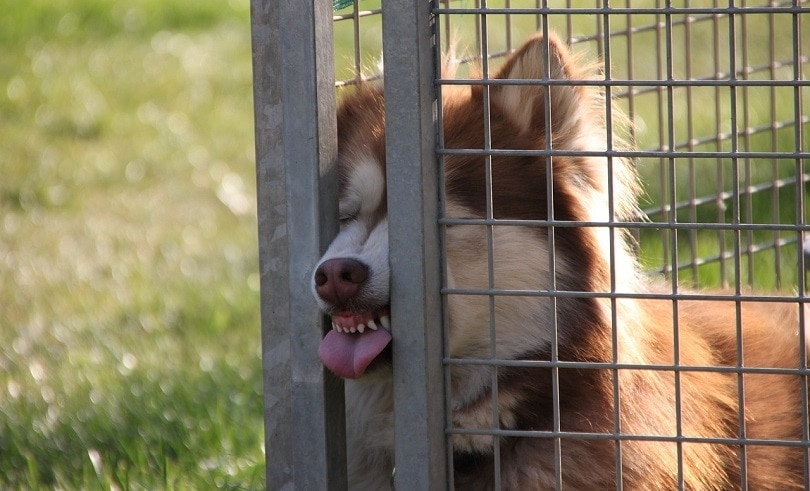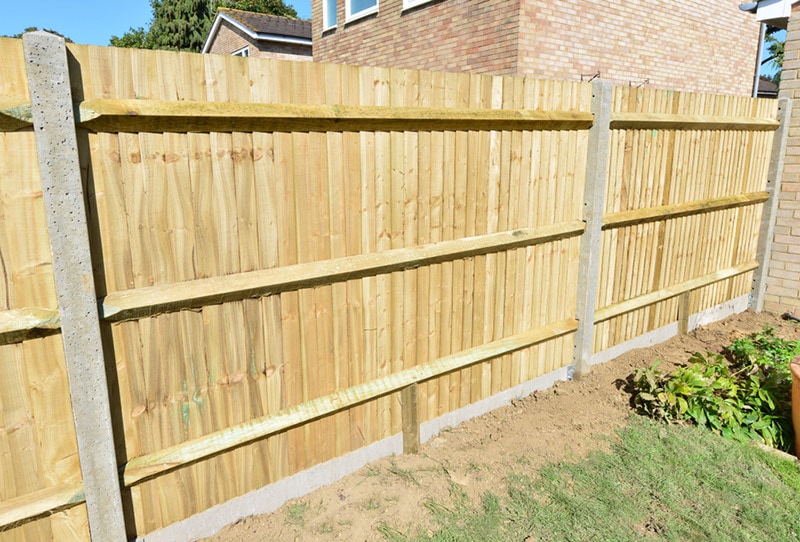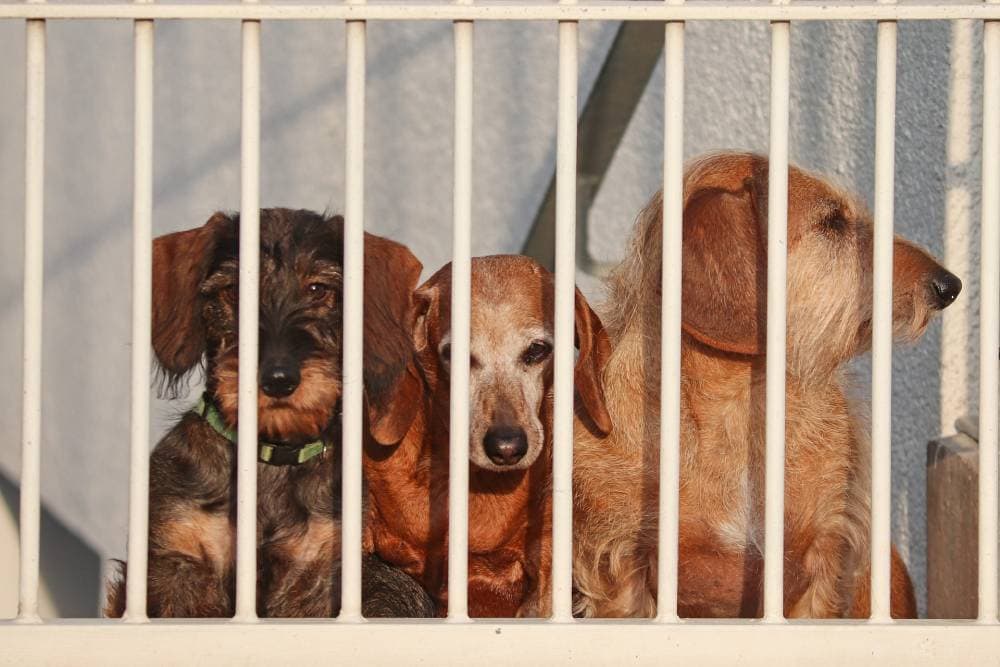How to Dog-Proof a Fence – 9 Great Options (With Pictures)
Updated on

Few things can make your blood run as cold as when you come home to find that your dog isn’t where you left them. It can be especially frustrating if you have a fenced-in yard, as that makes it feel like there’s nothing that you can do to keep your pup contained.
If you have a hairy Houdini on your hands, there are a few things that you can do to reduce the risk that they’ll escape every time you leave them home alone.
Below, we’ll walk you through nine of the best ways to dog-proof your fence. The solutions below make it much less likely that your pup will escape, giving you peace of mind and saving you money on fence repair.
The Top 9 Ways to Dog-Proof a Fence
1. Landscaping
One of the best ways to dog-proof fencing is to ensure that they don’t have access to the fence. Planting dense shrubs or other plants along the fence line can keep your dog from getting close enough to probe it for weaknesses. You can also install plants that discourage dogs from interacting with them, like rose bushes or cacti.
If your dog is escaping because they want to chase something outside the yard, heavy landscaping will block their vision of the outside world. This reduces temptation, which is as important as anything else that you could hope to accomplish.
2. L-Footing

Installing an L-footer on your wire fence is an excellent way to stop a digger in their tracks. This is basically an excess bit of wire that’s bent perpendicular to the fence and then buried, so when your pooch tries to dig beneath it, they’re confronted with more fence.
The fencing doesn’t need to be buried either. Many people just lay it down over the ground. While this is certainly easier, it provides less protection against a determined digger, and it could interfere with the growth of your grass.
3. Bamboo Rolls
Bamboo rolls are another excellent way to remove visual temptation. These slats can be rolled over existing fencing if it has gaps in it (like chain link), thereby blocking your dog’s view of what’s happening just outside your lawn.
Bamboo is lightweight yet extremely durable, so it shouldn’t weigh down your existing fence and your dog shouldn’t be able to chew through it. The only potential issue is how you attach it to your fence, as your pup may be able to pull it off if they’re truly determined to stage a breakout.
4. Coyote Rollers
These devices get their name from the fact that they’re excellent for keeping coyotes out, giving you another benefit beyond keeping your dog safely contained. They’re basically roll bars that cover the top of your wall, so any animal that tries to climb over won’t be able to find footing once they get there.
You can make coyote rollers yourself, and they’re an inexpensive way to boost your fence’s effectiveness. They’re best suited for brick or stone walls that are flat on top, but you can put them on virtually any kind of fence.
5. Lean-Ins

A lean-in is a portion of chain-link fence that extends above the actual fence, then is bent back toward the yard. The idea is that if your dog tries to go over the top of the fence, they’ll just be met with more fence, forcing them back into the yard.
This type of fencing is extremely effective for climbers, but it will do nothing to deter diggers. Also, if you’re worried about coyotes or other animals getting into your yard, this won’t do much to keep them out.
A concrete footer is the single most effective way to stop a digger, but it’s also pretty labor-intensive. It involves laying down concrete along the fence line and then planting your fence in it. Not only will this make the fence itself incredibly sturdy, but your dog will also have to dig through solid concrete to escape.
Of course, if your dog does manage to dig through the concrete, you should just let them do whatever they feel like doing. That dog’s the boss now (not really, of course).
7. Redundant Fencing

A redundant fence is just what it sounds like: a fence within a fence. It involves setting up a separate fence inside your yard to keep your dog away from the main fence. Not only will this give your dog more barriers to go through, but it can also cut down on behaviors like fence fighting with the neighbors’ dogs. It puts quite a bit of distance between your dog and the outside world, greatly reducing temptation.
Of course, putting up a second dog proof fence can be a pain, and it will greatly reduce the amount of usable space that you have in your yard. Also, if your dog is a master escape artist, it may only slow them down instead of stopping them entirely.
8. Airlocks

Airlocks aren’t the best idea for containing your dog when you’re not around, but if your pup loves to dash for the exit every time you open the gate, they may just be a lifesaver. An airlock is a small, fenced-in section outside the gate; it boasts a gate of its own, so your dog has to make it through two doors to escape.
You’ll find airlocks at many dog parks as well. In addition to keeping your dog secure, they also allow you to keep your dog isolated if you need to do something in the yard without their assistance. They won’t pose much of a challenge to a talented escape artist, though, so don’t leave your dog alone for long.
9. Puppy Bumpers

Puppy bumpers are unique on this list because they’re not something that you add to your fence — they’re something you add to your dog. These are oversized collars stuffed with dense material that stick out well beyond your dog’s neck. If your pooch tries to weasel through a small opening in the fence, the bumper will get snagged, keeping them in place.
Puppy bumpers are a helpful aid, but they may just slow your dog down (or convince them to make a bigger hole in the fence). You shouldn’t trust them to solve your problem on their own, and you’ll still want to make any necessary changes to your fencing.
Keep Your Dog Safe and Sound
Having a fenced backyard is a godsend if you have a hyperactive dog, but fences can also give you a false sense of security. Many people have lost dogs because they trusted a fence that proved to be less than secure.
However, with the alterations above, you can make your backyard as escape-proof as possible. This will allow you to leave home with confidence, knowing that your best friend will still be waiting for you when you get back.
Of course, once you’ve dog proofed your fence and your pup realizes that they can no longer escape, they may retaliate by tearing up your garden.
Related Read:
- How to Keep Dogs From Digging Under a Fence: 6 Helpful Ways
- Why German Shepherds Jump Over Fences: 5 Reasons & How to Stop It
Featured Image Credit: Jeannette1980, Pixabay











